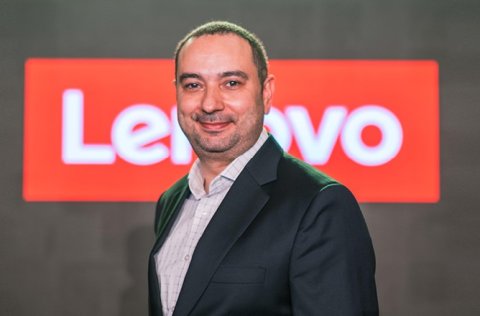Mohammed Hilili, General Manager, Intelligent Devices Group Gulf at Lenovo, has outlined the three major challenges facing CIOs in the current digital economy. 
Across industries, as technology becomes more central to business operations, the role of a CIO is increasingly broad. From digital transformation to the carbon footprints of data centres, CIOs are responsible for an ever-growing set of workstreams.
This is backed up by Lenovo’s Global Study of CIOs, which found that 84% of IT leaders believe they contribute to company success more than other C-suite leaders, and that nine out of ten believe that they are shouldering more responsibility than ever before. Lenovo’s global study also found that many are also worried that investment in innovation will ‘dry up’, leaving them unable to achieve their many goals, with 83% concerned that they will be left with insufficient budget.
Mohammed Hilili, General Manager, Intelligent Devices Group Gulf, Lenovo, said, “CIOs are now expected to make decisions on everything from business reporting and data analytics to diversity, equity, and inclusion. The most recent discoveries from Lenovo’s Global Study of CIOs indicate a growing weight of responsibilities on these leaders as their roles have become more critical to business success than ever before. As such, equipping CIOs with the right technologies will empower them to make more reliable and confident decisions in many of these areas and in turn, help companies run more efficiently and competitively.”
There are three challenges CIOs are currently contending with. Investing in the right technology can help ease the burden and deal with some of the key issues they face, including the evolving workplace, artificial intelligence (AI) and sustainability.
Challenge #1: The digital workplace
Technology is woven into every part of the modern workplace, functioning like a nervous system which joins together corporate strategy, operations, finance and innovation. This in turn loads more challenges onto CIOs, who are grappling with recruitment and retention (59%), managing a remote workforce (59%), and diversity, equity, and inclusion (55%). The technology environment is also changing, with employees now using two devices on average, combined with a sharp increase in ‘bring your own device’ usage.
For IT leaders, technology can help to bring simplicity to this shifting landscape. Optimising endpoints using one centralised platform helps to bring order to the chaos, this means that IT teams can focus on business-critical tasks, with end users enjoying a better experience, optimised by AI.
Meanwhile, ‘as-a-service’ models offer the flexibility and simplicity to empower teams with the technology they need, in a simple, scalable pay-as-you-go model. As-a-service models allow businesses to stay up to date with the latest and greatest technology, meaning that employees are never held back by older devices, and that less secure devices are not as likely to be used in the workplace. Lenovo’s research found that as-a-service options were highly popular with CIOs, with 92% saying they would consider adding new offerings over the next two years. This provides them with the flexibility to deploy hardware and software with ease, eliminating bottlenecks and freeing up teams to innovate rapidly and supercharge business strategy.
Challenge #2: Building intelligence
The current boom in generative AI has sparked a level of excitement around technology not seen since the dawn of the smartphone era. For CIOs, this poses further challenges: there is high expectation for organisations to engage proactively with AI, and for the technology to deliver business results, fast. The demand to engage with this emerging technology is very real, with 43% of CIOs saying they felt ‘urgent pressure’ to deal with AI.
But it’s not simply a case of buying solutions and sitting back and waiting for results: AI has to be used effectively. Edge computing technology helps to bring AI to the data source and will be hugely important for any organisations hoping to reap the benefits through cutting-edge applications such as virtual assistants, generative AI and computer vision. With edge computing, organisations can gain AI-powered insights right where data is created, which can be immediately used to improve outcomes across store aisles, manufacturing floors, hospital rooms and service desks all over the world. Edge AI computing can also process thousands of data points in real-time to gain the insights required to make decisions. In customer service, for instance, it can analyse data to make live recommendations for personalised products and services, or identify issues before they become pain points, enhancing the overall experience.
Technology that delivers data centre-like computing to the edge will be crucial to delivering improved experiences in industries from tourism to retail, as well as improved emergency response and public safety.
Challenge #3: Maintaining sustainability
In previous decades, sustainability has not fallen within the traditional purview of IT leadership. But with increasing attention on the issues such as e-waste, and the emissions associated with data centres, thinking about environmental, social and governance (ESG) issues is yet another responsibility on the shoulders of today’s CIOs.
With data centres responsible for up to 1.5% of global electricity use, according to the International Energy Agency, it’s critical that CIOs engage with technologies such as water cooling to increase efficiency and reduce electricity demand. Modern workloads mean that older air cooling technologies now struggle to keep up while becoming very expensive. Liquid cooling technologies will be an important factor in responsible computing going forward, and will also enable the sustainable supercomputers which will be crucial to tackling the challenges of climate change.
Decision-makers in IT must also be bold and move beyond the ‘make, use, destroy’ of the linear economy to the ‘design, use, return’ approach of the circular economy. The world produces 50 million tonnes of e-waste every year, and just a fifth of this is recycled. Asset recovery services (ARS) will be key to this, helping to find the most efficient and clean ways to deal with hardware at the end of its service life, whether that’s using the parts in manufacturing, refurbishing, reusing or environmentally friendly scrappage.
For CIOs grappling with the challenges of sustainability, the flexibility of ‘device as a service’ models, where devices are recycled or repurposed at the end of their service life, can also help switch to more efficient, environmentally friendly hardware without up-front capital outlay.
Meeting the challenge
“CIOs currently face challenges that would have been almost unimaginable 20 years ago, with responsibilities spanning everything from DE&I to ESG. Shouldering this increasing burden and being more central to an organisation’s success than ever before, it’s no wonder that it can feel like a lonely battle,” Mohammed Hilili added. “Thankfully, choosing the right technologies can make the role easier and empower CIOs to innovate, making a real difference for the business as a whole.”





